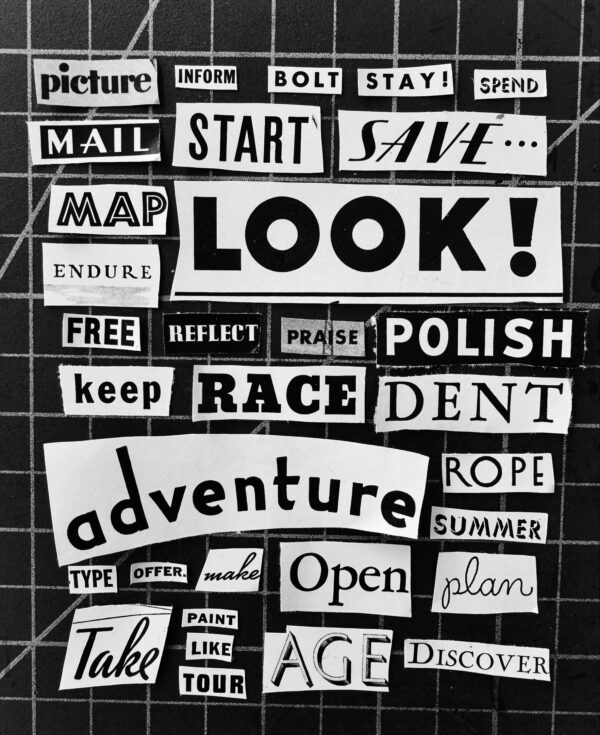
I usually don’t make art specifically for the newsletter, but I needed a top image for today’s edition, so I cut out Words from ads in the April 1935 issue of National Geographic.
Read the newsletter: “Verbify!”

I usually don’t make art specifically for the newsletter, but I needed a top image for today’s edition, so I cut out Words from ads in the April 1935 issue of National Geographic.
Read the newsletter: “Verbify!”
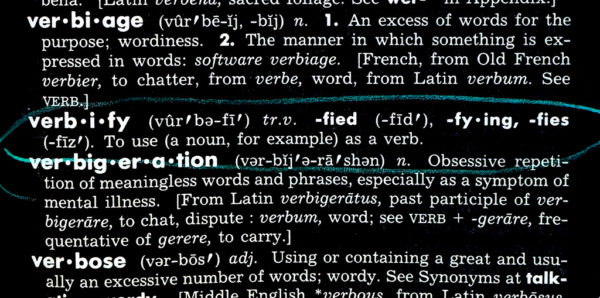
First, off: “verbify” is a word. It means what it sounds like: use something as a verb.
In 2015, the late comedian Norm Macdonald tweeted about the time he met Bob Dylan.
According to Macdonald, they talked about all kinds of stuff, like their favorite books of the Bible. (Norm said he liked Job, Bob said he liked Ecclesiastes.)
At one point, Macdonald said, “I remember he talked over and over about verbs and about ‘verbifying’, how anything could be ‘verbified.’”
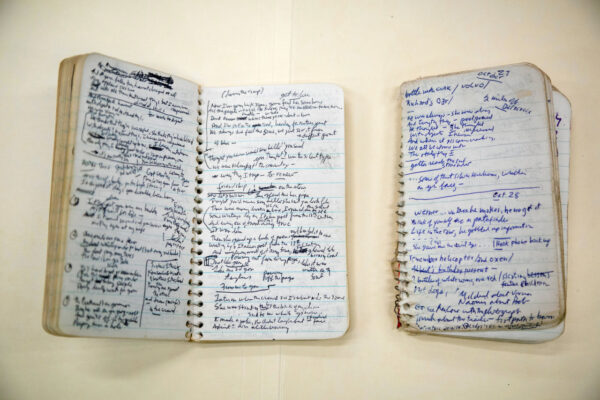
The writer Tony Conniff wrote a piece about Dylan’s use of verbs and used “Tangled Up in Blue” as an example:
They drove that car as far as they could
Abandoned it out West
Split up on a dark sad night
Both agreeing it was bestShe turned around to look at him
As he was walkin’ away
She said this can’t be the end
“We’ll meet again someday on the avenue”Tangled Up In Blue
“So much of the story,” Conniff writes, “is in the rich, vivid, and active verbs. It’s something you can find in almost any Dylan song.”
Of course, it ain’t like no other songwriter has ever talked about verbs before.
“When you’re writing a song,” said Chuck Berry, “nouns and verbs will carry you right through.”
UPDATE (9/20/2024): A reader sent me this Calvin & Hobbes cartoon about “verbing”:
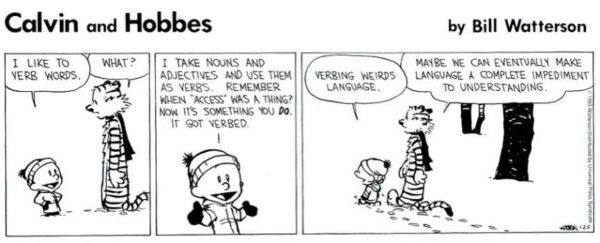
Filed under: Verbs.
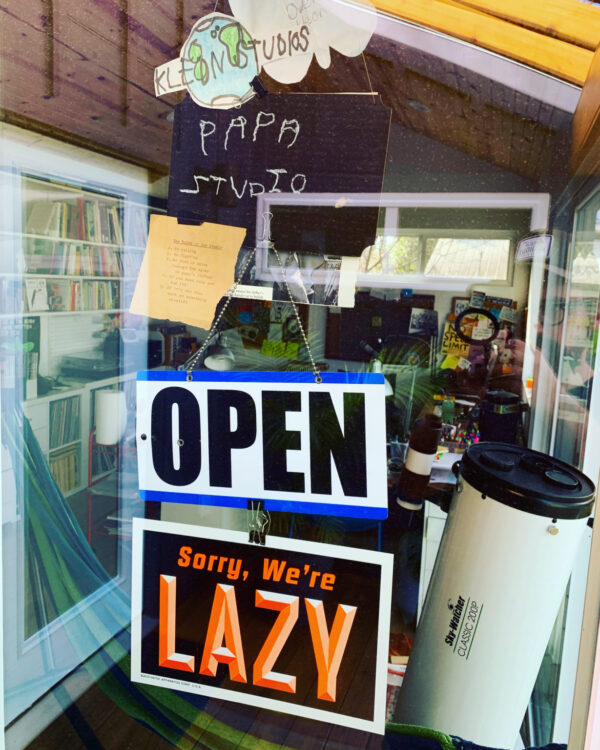
“Get yourself a little studietto where no one will bother you at all.”
—Cennino Cennini, Book of Art, c. 1400s
A delightful bit from Tom Stammers’ review of David Hall’s The Artist’s Studio: A Cultural History:
it’s helpful to know that the term ‘studio’ derives from a verb as well as a noun. Studiolo denoted the scholar’s study or cabinet, but there was also studiare, linked to a certain kind of diligent or pleasurable work, which could take place anywhere.
Another interesting bit on the difference between a “studio” and a “workshop”:
The idea that the artist’s studio was somehow different from the artisan’s workshop took off in the 15th century. In Hall’s phrase, ‘the Renaissance concept of the studio involved a literal and symbolic turning away from the street.’ The most skilful and profitable craftsman of the Middle Ages was the goldsmith, whose reputation for honest dealing was predicated on the transparency of his working practices. Goldsmiths’ shops were open to the street, and to watching customers. By contrast, the 15th-century artist’s studio was premised on a measure of secrecy.
I like this tension between “studio” and “workshop.” I would like to think of my space as serving both functions, occupying a place somewhere in the middle — a place I go to be, by myself, but also a place where the people are free to visit me. (I love a good visit.)
But even before I built my current studio, I knew that a great deal of my work “could take place anywhere,” and indeed, a great deal of it takes place, as it did before, in the morning at the kitchen table.

“When you’re writing a song, nouns and verbs will carry you right through.”
—Chuck Berry
The first exercise in Jeff Tweedy’s How To Write One Song is called a “Word Ladder.” (Not Lewis Carroll’s word game.) It goes like this:
Here’s how it worked when I tried it:
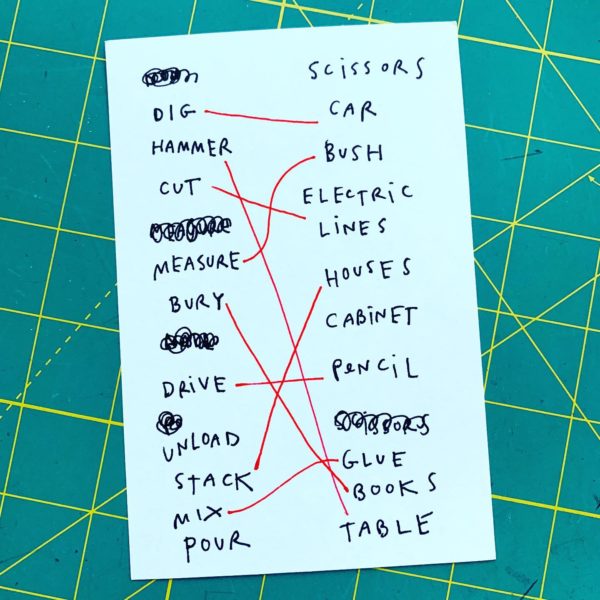
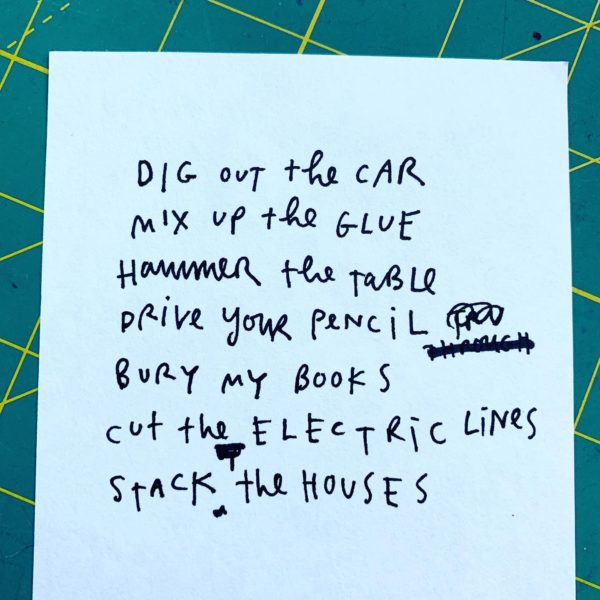
Nothing that great, but that’s not the point. The point is to loosen up and play with language to get your brain going. Tweedy writes:
“I like to use this exercise not so much to generate a set of lyrics but to remind myself of how much fun I can have with words when I’m not concerning myself with meaning or judging my poetic abilities…. I find it almost always works when I’m feeling a need to break out of my normal, well-worn paths of language.”
“Nouns and verbs” is also the really basic advice I give to people who are trying out blackout poetry for the first time.
For example, here’s one I started by just underlining nouns and verbs that popped out at me:

And that led to this:
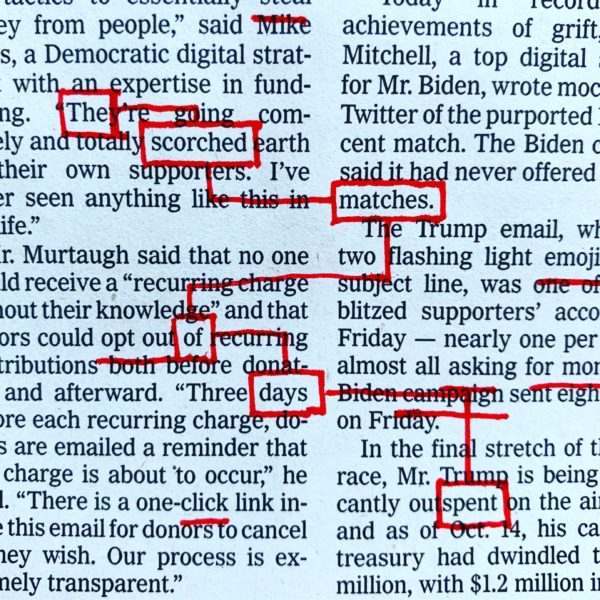
And seeing that, I realized with a little Photoshop cheat (is it cheating if there ain’t no rules?) I could “fix” it to this:
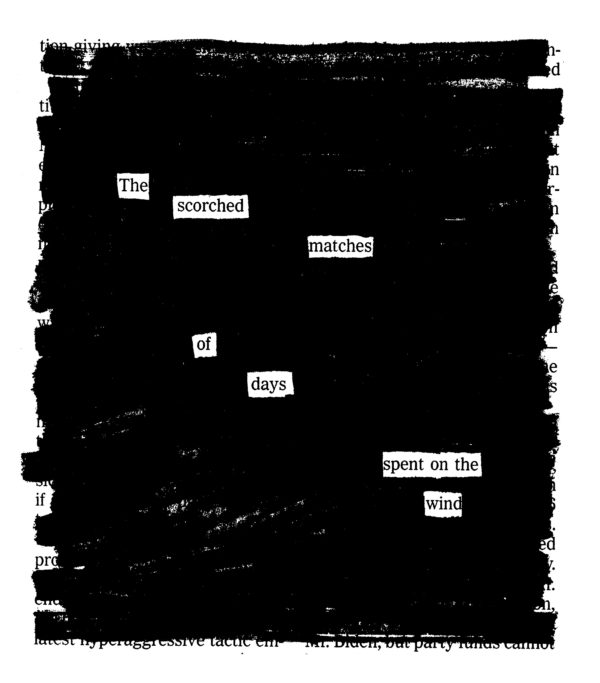
Not my best work, but, again, not the point. Plus, it only took me 10-15 minutes. (By the way, exercise #2 in Tweedy’s book is called “Stealing Words From A Book.” Stealing has, of course, always worked for me!) Give it a try next time you’re stuck.
Nouns and verbs, y’all. They’ll take you right through.
Related reading: “A bag of words” & “We are verbs, not nouns”

I was driving my rental car back to the airport from a gig yesterday and I caught an interesting interview with religion scholar Elaine Pagels (author of Why Religion?) on Fresh Air.
“You know, Terry, I think that belief is overrated.” she said.
Talking about religions as if they were about belief takes an image that’s basically forged in Christian tradition and applies it to Judaism, applies it to Buddhism or Hinduism. And in other traditions, belief is not so much the center as practice — saying the prayers, saying the Shama or going to worship, participating with others in certain acts, prayer.
She then spoke about her own spiritual practices:
I go to an Episcopal church often. I love the music. The person who’s the priest there is a man of spiritual depth, which I deeply appreciate. I go to yoga almost every day. That’s a physical and also contemplative practice. Meditate sometimes. I walk in the woods, see my friends… I’m enormously susceptible to what you spoke of before — the music, the rituals, the traditions, the prayers that I find there and also, too, those that we create. I wrote about also creating rituals, and many people do that. Many artists do that. And what many artists do is, feels to me, very closely akin to what I’m talking about.

Related reading: “We are verbs, not nouns”
This site participates in the Amazon Affiliates program, the proceeds of which keep it free for anyone to read.